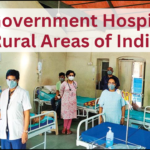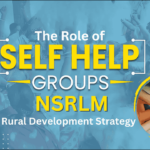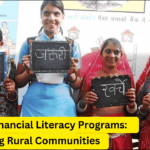
In rural India, a single stable job can transform the economic reality of an entire household. The National Rural Livelihood Mission (NSRLM) recognizes this powerful truth and has developed comprehensive approaches to skill development and employment generation. This article explores how NSRLM’s initiatives are bridging skill gaps, creating employment opportunities, and systematically lifting families out of poverty.
Table of Contents
What is NSRLM’s Approach
The Deendayal Antyodaya Yojana-National Rural Livelihoods Mission (DAY-NRLM) operates on a fundamental principle: securing one formal sector job per poor household can rapidly elevate an entire family above the poverty line. This approach brings immediate benefits through stable income streams and creates long-term economic security.
The mission addresses a critical challenge in rural employment, the mismatch between available skill and market demands. By focusing on skill development that aligns with industry needs, NSRLM prepares rural youth for meaningful employment opportunities.
How DDU-GKY Works
At the heart of NSRLM’s skill development initiative is the Deen Dayal Upadhyaya Grameen Kaushalya Yojana (DDU-GKY). This program offers an end-to-end solution that transforms unemployed rural youth into skilled workers ready for the job market.
| Phase | Key Activities |
|---|---|
| Identification | Finding unemployed rural youth from BPL families |
| Training | Providing demand-driven skill development and training |
| Placement | Connecting trained youth with suitable employment opportunities |
| Support | Offering post-placement guidance, counseling, and mentorship |
| Community | Building alumni networks for ongoing career development |
Unlike many skill development programs that stop at training, DDU-GKY’s holistic approach ensures participants not only acquire skills but also secure and retain quality employment.
Training Program Structure
NSRLM training programs are carefully designed to address both technical skills and workplace readiness. The training structure typically includes:
| Component | Description | Duration |
|---|---|---|
| Technical Skills | Industry-specific competencies required for job roles | 60-70% of training time |
| Soft Skills | Communication, teamwork, workplace etiquette | 10-15% of training time |
| Basic Computer Literacy | Essential digital skills for modern workplaces | 10% of training time |
| Financial Literacy | Personal finance management and banking awareness | 5% of training time |
| English Communication | Basic English for workplace communication | 10-15% of training time |
This balanced approach ensures participants are prepared not just for their first job but for long-term career growth.
Job Sectors
NSRLM has identified several high-growth sectors that offer substantial employment opportunities for rural youth:
| Sector | Types of Roles | Average Starting Salary |
|---|---|---|
| Healthcare | Patient care assistants, medical equipment operators | ₹12,000-15,000/month |
| Hospitality | Housekeeping, food service, front office staff | ₹10,000-14,000/month |
| Retail | Sales associates, inventory managers | ₹10,000-12,000/month |
| Automotive | Assembly line workers, quality checkers | ₹12,000-16,000/month |
| IT/ITES | Data entry operators, BPO professionals | ₹12,000-18,000/month |
| Construction | Skilled construction workers, machine operators | ₹15,000-20,000/month |
These sectors offer entry-level positions with clear career advancement paths, allowing participants to grow professionally over time.
Why NSRLM Training Works
Several key factors contribute to the effectiveness of NSRLM’s skill development initiatives:
- Demand-driven curriculum: Training programs are designed based on extensive industry consultation, ensuring skills taught match actual job requirements.
- Quality training infrastructure: Well-equipped training centers with modern facilities provide a conducive learning environment.
- Qualified trainers: Experienced professionals with industry expertise deliver practical, relevant training.
- Mandatory placement linkages: Training partners are required to ensure placement for at least 70% of participants.
- Comprehensive support system: From enrollment through post-placement, participants receive continuous guidance and support.
Challenges and Solutions
Despite its successes, NSRLM’s skill development programs face several challenges:
| Challenge | Mitigation Strategy |
|---|---|
| High dropout rates | Enhanced pre-enrollment counseling and family engagement |
| Regional skill-job mismatches | Location-specific training programs based on local industry needs |
| Post-placement retention issues | Strengthened mentorship and ongoing career guidance |
| Language and cultural barriers | Cultural adaptation training for jobs requiring migration |
| Limited awareness of opportunities | Community mobilization campaigns and success story sharing |
NSRLM continually refines its approaches based on feedback and outcome analysis, ensuring programs remain effective and relevant.
Real Impact on People
While quantitative metrics like placement rates and salary levels are important, NSRLM also tracks qualitative impacts such as:
- Improved household economic stability
- Enhanced social status within communities
- Development of financial discipline and savings habits
- Increased educational aspirations for the next generation
- Greater gender equality through women’s economic empowerment
These broader impacts highlight how skill development creates ripple effects that transform entire communities.
What’s Next
Looking ahead, NSRLM is expanding its skill development initiatives in several directions:
- Digital skills integration: Ensuring all training programs include digital literacy components relevant to modern workplaces.
- Green skills development: Preparing rural youth for emerging opportunities in renewable energy, sustainable agriculture, and eco-tourism.
- Entrepreneurship pathways: Creating linkages between skill training and self-employment support for those interested in starting micro-enterprises.
- Industry-embedded training: Increasing on-the-job training components through industry partnerships.
- Recognition of prior learning: Developing frameworks to certify skills gained through informal learning and experience.
Conclusion
NSRLM’s approach to training and skill development represents a thoughtful, comprehensive strategy for addressing rural poverty through employment generation. By focusing on demand-driven training, placement linkages, and post-placement support, the program creates sustainable pathways out of poverty for rural families.
The success of these initiatives demonstrates that with the right skills and opportunities, rural youth can become powerful economic contributors not only to their families but to India’s growing economy. As NSRLM continues to refine and expand its approaches, it remains a vital force in transforming rural livelihoods across the country.









